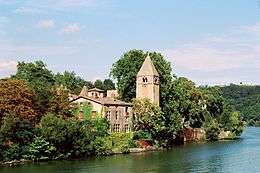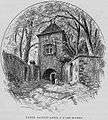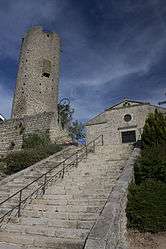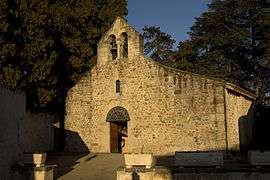Île Barbe
The Île Barbe is an island situated in the middle of the Saône, in the 9th arrondissement de Lyon, the quartier Saint-Rambert-l'Île-Barbe (a former-commune annexed in 1963). Its name comes from the Latin insula barbara, "Barbarians' Island", suggesting that it was one of the last locales to be occupied (two centuries after the banks of the Saône at the foot of the hill of Fourvière).
 Église romane Notre-Dame | |
 Île Barbe | |
| Geography | |
|---|---|
| Location | Saône |
| Coordinates | 45°47′50″N 4°49′54″E |
| Highest elevation | 171 m (561 ft) |
| Administration | |
France | |
| Région | Rhône-Alpes |
| Département | Rhône |
| Commune | Lyon |
Geography
History
An abbaye was founded on the island in the 5th century. This was the first monastic establishment in the Lyon region and one of the oldest in all of Gaul. Charlemagne gave it a beautiful library.
The monastery, pillaged several times – (in 676 and 725 by the Saracens, and in 937 by the Huns[1]), adopted the Rule of Saint Benedict règle de saint Benoît in the 9th century and gradually was enriched.
In 816, Louis the Pious (Louis le Pieux) awarded to the monastery:
- the right to maintain at all time three boats upon the Saône, the Rhône and the Doubs exempt from taxes for passage;[2]
- a decree of immunity and protection for the monastery[3] confirmed by Charles the Bald Charles le Chauve in 861.[4]
At the beginning of the 16th century, the abbey passed into the ownership commende of the bénéfice of the Albon family famille d'Albon.
In 1549, the abbey was secularised and the monts became a college of canons chanoines (collégiale).
In 1562, it was looted and burned by Protestant troops troupes protestantes of the Baron des Adrets baron des Adrets.
The chapter of canons chapitre des chanoines finally was suppressed in 1741, and an establishment for aged or infirm priests was established, which was suppressed in its turn in 1783. At the Revolution, everything remaining on the island was sold and dispersed.
 Porte Sainte-Anne illustrated by Joannès Drevet (1854–1940).
Porte Sainte-Anne illustrated by Joannès Drevet (1854–1940). L'Île-Barbe at the beginning of the 19th century.
L'Île-Barbe at the beginning of the 19th century. The Ile barbe at Lyon today.
The Ile barbe at Lyon today.
The first bridge
In the 17th century, or in 1734, the architect Cotton constructed a wooden bridge which provided access to the Ile Barbe[1] In 1827, a suspension bridge replaced it (it is the oldest in Lyon still in service). It is reached from the passerelle Masaryk and the passerelle Saint-Vincent), crossing the island at the level of its southern point and permitting the juncture of the left and right banks of the Saône, the villages of Saint-Rambert (today Lyon 9e) and of Caluire-et-Cuire. For more information about this suspension bridge one may consult the page here dedicated to Bridges of Lyon Ponts de Lyon. During the years 1870–1880, three well-reputed rowing clubs were located here: the Aviron Club de Lyon-Caluire, the Aviron Union Nautique de Lyon (6e club français) and the Cercle de l'Aviron de Lyon (5e club français).
List of abbots and church figures
- 2??–??? : Dorothée[5]
- ???–??? : Philetus
- ???–??? : Julien
- ???–??? : Christophe
- ???–??? : Antoine Ier
- ???–??? : Martin
- ???–??? : Aigobert
- ???–??? : Astorg Ier
- ???–??? : Maxime
- ???–??? : Ambroise
- ???–??? : Loup
- ???–??? : Maximin
- ???–??? : Bligigaire
- ???–??? : Vinfrid
- ???–??? : Rotfred
- ???–??? : Garland
- ???–??? : Licinius
- ???–??? : saint Benoît Ier
- ???–??? : Campion
- ???–??? : Alaric
- ???–??? : Bartholomée
- ???–??? : Argeric
- ???–861 : Herbert
- 861–8?? : Gundramnus
- 8??–8?? : Norbert
- 8??–8?? : Varengard
- 8??–876 : Garlarin
- 876–8?? : Léobon
- 8??–??? : Astorg II
- ???–??? : Étienne
- ???–??? : Elgedis
- ???–??? : Antoine II
- ???–??? : Halinand
- ???–??? : Romuald
- ???–??? : Eudes
- ???–971 : Cumanus
- 971–994 : Heldebert
- 994–1007 : Benoît II
- 1007–1008 : Bernard
- 1008–1055 : Garnier
- 1055–1070 : Humbert
- 1070–10?? : Ogier
- 10??–1096 : Clément
- 1096–1116 : Guy Ier
- 1116–1128 : Girin Ier
- 1128–11?? : Josserand
- 11??–11?? : Hugues Ier
- 11??–11?? : Olderic
- 11??–1150 : Guillaume Ier
- 1150–1152 : Girin II
- 1152–11?? : Saturnin
- 11??–1168 : Vicard
- 1161 : Hugues de Tournon "Moine"
- 1168–1183 : Hugues II
- 1183–1198 : Guichard,[6] abbé
- 1198–1200 : Gaucerand
- 1200–1222 : Guy II
- 1222–1224 : Bermond
- 1224–1243 : Guillaume II de Jarez
- 1243–1245 : Foulques
- 1245–1246 : Omer
- 1246–1250 : Pierre Ier
- 1349 : Zacharie de Talaru "Moine"
- 1250 : Hugues de Varennes "Moine & Cellerier"
- 1250–1261 : Geoffroy de Vertelay
- 1256 : Zacharie de Talaru "Moine"
- 1261 : Humbert de Vassailleu "Moine"
- 1261–1270 : Pierre II de Vertelay
- 1270–1296 : Girin III de Sartines
- 1272 : Aymon de Vaux "Prieur Claustral"
- de 1284 à 1440 : Hugues, Jean, Pierre & Pierre puis Claude de Roncherol "Moines"
- 1284 : Robert de Ryon "Religieux"
- 1296–1322 : André de Marzé
- 1300 : Estienne de Vego "Moine"
- 1309 : Guigues de Roussillon "Moine"
- 1322–1329 : Béraud Ier de Mercœur
- 1329–1334 : Pons de Guizeu
- 1334–13?? : Raymond de Beaufort
- 13??–13?? : Béraud II de La Baume
- 13??–1345 : Galbald
- 1345–134? : Simon de Gillans
- 134?–1350 : Bégon de Brossan
- 1350–1354 : Jean Ier Pilus-Fortis de Rabastens
- 1354–1372 : Guillaume III de Landore
- 1372–1394 : Pierre III de Villette
- 1383 : Pierre de Verriere "Aumosnier"
- 1394–1400 : Jean II de Sonhetto
- 1400–1428 : Pierre IV de Thurey
- 1401 : Pierre de Verriere "Aumosnier"
- 1411 : Faucerand du Saix "Religieux"
- 1419 : Antoine de Salornay "Moine"
- 1421 : Faucerand du Saix "Religieux"
- 1421 : Jean Rostain "Moine"
- 1428–1436 : Aynard de Cordon
- 1436 : Durand Vert "Moine"
- 1436 : Berno de Vienne "Moine"
- 1436 : Durand Vignols "Religieux"
- 1436–1458 : Claude Ier de Sotizon
- 1451 : Antoine de Rochefort la Valette "Moine"
- 1452 : Jean de Vaugrigneuse "Moine"
- 1453 : Eustache de Vaugrigneuse "Moine"
- 1453 : Aynard de Villeneufve "Chantre"
- 1455 : Guillaume de la Sale "Moine"
- 1458–1485 : Edouard de Messey
- 1464 : André le Viste "Religieux"
- 1485-1488 : cardinal Charles de Bourbon
- 1488–1500 : Henri de Seylac
- 1500 : Philibert Rosset "Moine"
- 1507 : Guyllaume de Villeneufve "Moine"
- 1500–1515 : Antoine III d’Albon de Saint-André
- 1500 : Jacques de Sassenage "Religieux"
- 1505 : Guillaume de Semur "Religieux & Chamarier"
- 1515–1525 : Antoine IV d’Albon de Saint-Forgeul
- 1525–1562 : Antoine V d’Albon de Saint-Forgeul
- 1550 : Claude Sautreau "Moine & Chantre"
- 1551 : Fleury de Salemard "Religieux Cloistrier"
- 1551 : Louis Vallier "Moine"
- 1551 : Antoine de Vauselles "Moine"
- 1562–1599 : Pierre V d’Espignac
- 1599–1609 : Jean III de Châtillon
- 1606–1613 : Claude II de Nérestang
- 1616–1620 : Antoine VI de Nérestang
- 1620–1693 : Camille de Neufville de Villeroy
- 1630–1660 : Claude Le Laboureur, prévôt du chapitre
- 1693–1741 : Antoine VII de Thélis de Saint-Cyr de Valorges
Source : Gallia Christiana
Possessions of the abbey
Partial list of possessions held in its own name or in-fief by the abbey[7] · :[8]
Lyonnais
- fief et terres de Pollet, près Villefranche ;
- château de Lignieux, à Saint-Jean-de-Thurigneux (1186–1665) ;
- château de Miribel, à Miribel;
Jarez
- Celle Saint-Martin de Firminy (971)
- Église Saint-Pierre "in Amodo" (Saint-Chamond?) (971)
- Église de Tartaras (1168–1183 – c. 1225)
- Église de Saint-Romain-en-Jarez (1168–1183 – c. 1225)
- Église de Saint-Paul-en-Cornillon (1225)[9]
- La chapelle de Grangent (1183)
- Église Saint-Julien de la Tour-en-Jarez (1183), dépendant de Saint-Rambert-sur-Loire (c. 1225)[10]
- Église Saint-Martin de la Fouillouse (1183), dépendant de Saint-Rambert-sur-Loire (c. 1225)
- Église de Bouthéon (1183), dépendant de Saint-Rambert-sur-Loire (c. 1225)
- Église Saint-Clément du Chambon-Feugerolles (1183), dépendant de Saint-Martin de Firminy
- L'église Saint-Clément au Chambon-Feugerolles.
- Église de Saint-Laurent-d'Agny, dépendant de Saint-Rambert-sur-Loire (c. 1225)
- Église de Thurins, dépendant de Saint-Rambert-sur-Loire (c. 1225)
- Église de Veauche, dépendant de Saint-Rambert-sur-Loire (c. 1225)
- Église de Saint-Héand, dépendant de Saint-Rambert-sur-Loire (c. 1225)
- Église de Chevrières, dépendant de Saint-Rambert-sur-Loire (c. 1225)
Forez
- L'église Saint-André de Occiaco (monastère de Saint-Rambert) (971), les églises Saint-Côme (971) et Saint-Damien (1183) jusqu'à Noailleux (971)
-Tour_du_Prieur%C3%A9_(cour).jpg) Église de (Saint-Rambert-sur-Loire).
Église de (Saint-Rambert-sur-Loire).
- La Celle-Saint-Martin en Forez et église Saint-Bonnet de Cléppé (971)
- Eglise Sainte-Marie de Cottance (971)
- Église Sainte-Marie-Madeleine du château de Saint-Germain-Laval (1183)
- Église Sainte-Foy-Saint-Sulpice (1183)
- Chapelle Sainte-Foy-Saint-Sulpice.
- Ste-Foy-St-Sulpice, état délabré de la chapelle .
- Église de Magneux-Haute-Rive (1183)
- Église de Mizérieux (1183)
- Église de Marclopt (1183) dépendant de Saint-Rambert-sur-Loire (v. 1225)
- L'église Saint-Martin de Marclopt
- Église de Sainte-Agathe (Sainte-Agathe-la-Bouteresse?) (1183)
- Église de Civens (1183)
- Église de Châtelus (1183) dépendant de Saint-Rambert-sur-Loire (v. 1225)
- Église du Sury-le-Comtal (1183)
- Église de Saint-Romain-le-Vieux (Chazelles-sur-Lyon, aujourd'hui hameau "La Tour") (1183)
- Église de Chambles (1183), dépendant de Saint-Rambert-sur-Loire (v. 1225)
 La Tour et l'église de Chambles.
La Tour et l'église de Chambles.
- Église de "Benerone" (Bonson) (1183), dépendant de Saint-Rambert-sur-Loire (v. 1225)[11]
 Chapelle Notre-Dame de Bonson.
Chapelle Notre-Dame de Bonson.
- Église de Saint-Just-sur-Loire (1183)
- Église Saint-Romain de Jonzieux (1183)
- Église de Saint-Bonnet-le-Château, dépendant de Saint-Rambert-sur-Loire (v. 1225)
- Sainte-Croix-en-Jarez (1280)
- Villa de Triols (Luriecq) (1283)
The Ile today
In the 21st century, the abbey consists of nothing more than the Romanesque église romane Notre-Dame. Only the northern part of the Ile may be visited (about one-half of the island) which consists of old private homes and a few vestiges of religious buildings. One also may find a gastronomic restaurant, of the chain Relais & Châteaux, the « Auberge de l'Île ». Also intact are some remains of a lodging reconstructed in about 1840 as the château de Saint-Rambert-l'Ile-Barbe or château du Fresnes, also the château du Chastelard of the 15th century, reconstructed in the 16th century.
A dwelling place for several persons, posh and privileged, the Ile is reached by a 10-minute bus ride from the gare de Vaise (bus TCL 31 et 43 côté Lyon-St Rambert), and 15 minutes from the Place Bellecour (bus TCL 40 côté Caluire).
The Ile is composed of a public part – terrains for pétanque, a large lawn, a children's playground – and a private part reached via two roads, l'impasse Saint-Loup for reaching the Auberge and the chemin du Bas-Port leading to the Saône). These two paths are not joined, the impasse Saint-Loup ends at the door to a private courtyard.
- Pont de l'île Barbe
 Vestige of the église Saint-Loup
Vestige of the église Saint-Loup
Notes and references
- Lyon Historique - L'île Barbe
- Louis le Pieux accorde à l’abbaye de l’Ile-Barbe la faculté de disposer en tout temps de trois navires (816). Proposition de traduction par le musée du diocèse de Lyon Lire en ligne
- Décret d'immunité de Louis le Pieux en faveur de l’abbaye de l’Ile-Barbe (816). Proposition de traduction par le musée du diocèse de Lyon Lire en ligne.
- Le roi Charles à l’abbaye de l’Ile-Barbe (861). Proposition de traduction par le musée du diocèse de Lyon Lire en ligne
- Vies des Saints du diocèse de Lyon par François-Zénon Collombet (1835)
- Topographie historique du département de l'Ain, p. 201.
- Les Mazures de l'abbaye royale de l'Isle-Barbe, Tome 1. p. 67 and p. 117. Lire en ligne
- Diplôme de Conrad roi de Bourgogne pour Heldebert, abbé de l’Ile-Barbe à Lyon, année 971. Traduction proposée par le musée du diocèse de Lyon Lire en ligne
- J.-E. DUFOUR, Dict. topographique du département de la Loire (1946), p. 246.
- Auguste Longnon, Pouillés de la province de Lyon, 1904. Lire en ligne
- "En 1225 la cure de Bonson avait pour collateur le prieure de Saint-Rambert". J.-E. DUFOUR, Dict. topographique du département de la Loire (1946), PUSE, 2006, p. 87.
See also
| Wikimedia Commons has media related to Île Barbe. |
Bibliography
- Claude Le Laboureur, Les masures de l'abbaye royale de l'isle Barbe lez Lyon, Lyon, 1665 disponible sur Google Books, rééd.par M.-C. et G. Guigue, Lyon, 1887–1895.
- Bésian Arroy, Brève et dévote histoire de l'abbaye de l'Isle Barbe, Lyon, 1668.
- L. Niepce, L'île-Barbe. son ancienne abbaye et le bourg de Saint-Rambert, Lyon, 1890
- M.M. Bouquet, L'abbaye de l'Ile-Barbe, des origines à la sécularisation, dans Positions de thèses de l'École des Chartes, Paris, 1938, pp. 13–21
- J. Picot, La seigneurie de l'abbaye de l'Ile-Barbe, Lyon, 1953
- J. Picot, Ile-Barbe, DHGE, XXV, 1995, c. 811–817
- J.-F. Reynaud, Le monastère de l'Ile-Barbe et le bourd de Saint-Rambert dans Saint-Rambert, un culte régional depuis l'époque mérovingienne. Histoire et archéologie., Paris, 1995, pp. 49–60
- Michel Rubellin, Église et société chrétienne d'Agobard à Valdès, PUL, 2003, Lyon, pp. 265–275.
- Robert Favreau, Un tympan roman à l'Île-Barbe près de Lyon, dans le Comptes-rendus des séances de l'Académie des Inscriptions et Belles-Lettres, 2005, Vol. 149, n° 3, pp. 1007–1025
- Mémoire de pierres : Abbaye de l'Ile-Barbe, Lyon, 1995, Musée historique de Lyon, catalogue d'exposition Septembre 1995 - Janvier 1996, ISBN 2-901307-07-8
